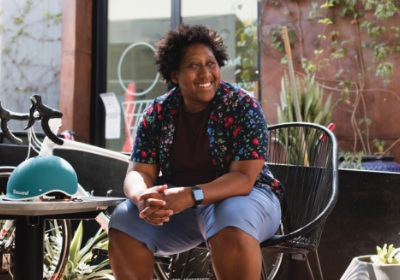THE OLDER WOMAN WHO BIKES UP AND down my West L.A. neighborhood is hard to miss. She braids her white hair into pigtails and ties them off with colored ribbons. The ribbons coordinate with her outfits — typically flashbulb-bright pink, red or orange sweats. In the years since she has become a morning fixture, I have never seen her wear a helmet.
At 73, I feel a bit like her when I pedal to the library or meet a friend for coffee: odd, flamboyant, probably reckless.
Cycling can be an act of faith in this car-dense city, especially for women like me with old bones for whom getting “doored” risks a calamitous fracture.
It’s sensible for me to stop riding. But I don’t want to.
Biking makes so much sense here, especially for short trips. Los Angeles is largely flat — 87% of the city’s streets have less than a 5% grade, according to city data. Our weather is famously mild, and it’s far more pleasant and often quicker to bike to my Ralphs for a quart of milk than to drive, especially at rush hour.
Until recently, however, transportation planners have treated L.A.’s bicycle infrastructure more as a “nice to have” than a realistic alternative to cars and public transit. Moreover, the existing bike lanes, rental city bikes, bike racks and lockers at Metro stations are often poorly maintained or vandalized.
We can do better. A ballot measure city voters approved last March should help.
Nearly half of all trips within the Greater L.A. area are three miles or less, or a 15-minute bike ride away, according to L.A.’s Mobility Plan 2035. Nonetheless, we make more than 80% of those trips in our cars. There are good reasons why — children need to get to school, and it isn’t easy to cart home a week’s worth of groceries on two wheels.
Yet for me and many others, running an errand on a bike can be a balm for the soul. In spring, blooming jasmine perfumes my rides. Red maple leaves crunch under my tires in autumn. Instead of fuming behind a line of cars, I hear the soft whir of my ancient Trek gears, and it makes me feel lucky to be alive.
City planners drafted the mobility plan in 2015 to lure more of us out of our cars. The extensive blueprint, which the City Council quickly adopted, would gradually add hundreds of miles of bike and bus lanes, among other improvements, over 20 years, as each L.A. street is scheduled for resurfacing. The goal is to make travel safer for pedestrians and bus riders, as well as for bicyclists, and to reduce the city’s alarming toll of traffic fatalities — now among the nation’s highest.
But in the past nine years, city leaders have basically ignored Mobility 2035, according to Michael Schneider, who heads Streets for All. Crews have completed only 5% of the plan’s upgrades, according to the advocacy group. COVID was partly to blame, as was a lack of coordination between street crews who repave and transportation officials responsible for implementing upgrades as the repaving happens.
Schneider’s group helped put Healthy Streets L.A. on the ballot last March. The citizen initiative is intended to force the city to act on its 2015 commitment by allowing residents to sue for noncompliance. Voters resoundingly approved the measure, and it won a majority in every council district.
Long-proposed upgrades to Venice and Hollywood Boulevards are two examples of how things could improve for cyclists like me.
Portions of the existing pockmarked bike lane along Venice Boulevard are being upgraded with new green paint and plastic bollards separating cyclists from cars. Schneider’s group, along with others, hopes to extend these improvements eastward to downtown. A new protected bike lane now runs along Hollywood Boulevard between Gower Street and Lyman Place, and other measures are in the works to slow traffic and safeguard waiting bus passengers.
Not everyone has been on board with these changes, especially when the space for bike lanes and bus boarding islands takes away a car lane. And city budget cuts may again slow progress. Moreover, since compliance may rest on bringing suit, residents with the time and resources to sue likely live in the city’s wealthier neighborhoods. As a result, Healthy Streets L.A. may unintentionally exacerbate existing transit disparities.
Still, I’m far from the only Angeleno who welcomes these improvements.
The success of temporarily opening neighborhood streets to just cyclists, skaters and strollers — regional CicLAvias — demonstrates that when riders feel safe, urban cycling is a fun and viable way to get around. The 53 CicLAvias (and counting) have drawn 1.8 million people of all ages from across L.A. County since 2008.
Nor am I and our local pigtailed cruiser the only Boomers in the saddle. I recently joined a Facebook group for cyclists over 70 where, instead of the usual senior kvetching about ailments, 70- and 80-somethings share their triumphs: Back on the bike following an aortic valve and knee replacement! Selfie with neck brace and road rash after a tumble, but still smiling!
I aim to be like these folks — minus the emergency room visits. I want to ride into my 80s, carefully but a bit delusional about the inevitable toll of age, and ever grateful to feel the breeze on my face.
























